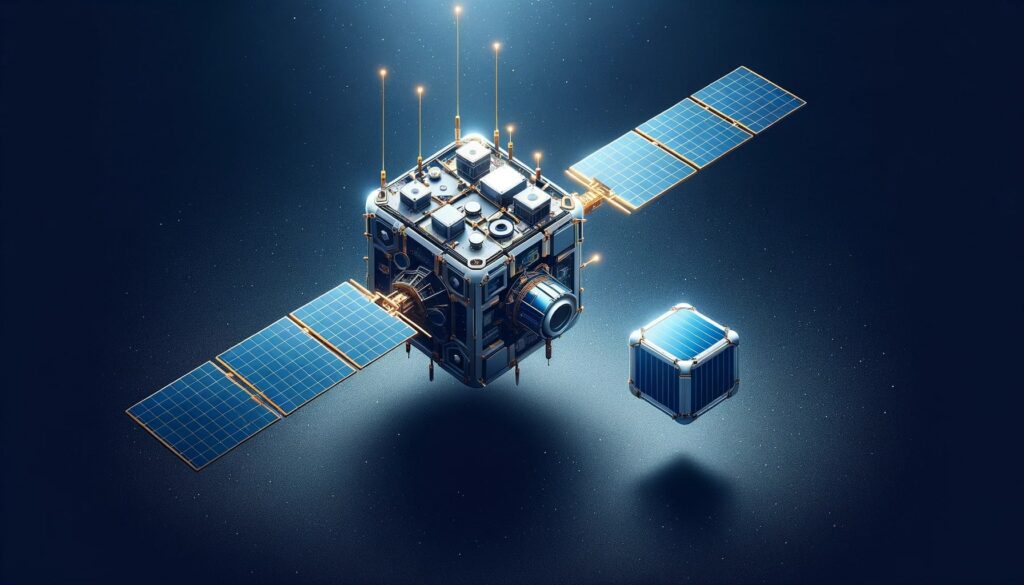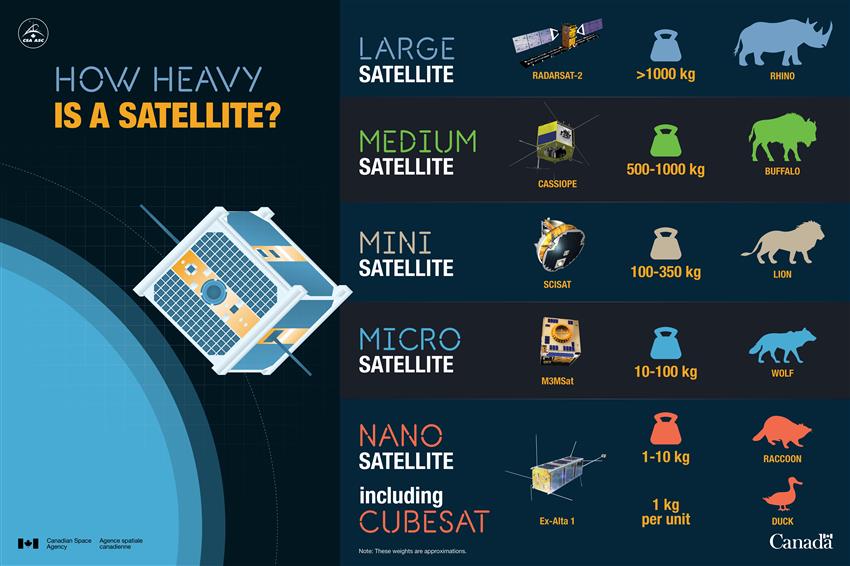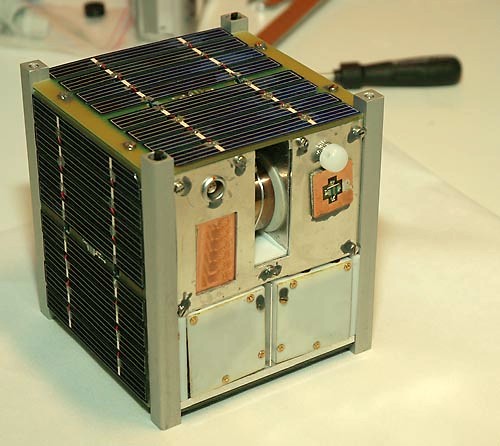
“Exploration of the earth observation, astronomy, and space operations is really the essence of understanding the space environment.” – Frank Borman
In the ever-evolving space economy, nanosatellites, also known as cubesats or microsatellites, have emerged as a game-changer on the cubesat platform. These cubesats and nanosatellites, which are part of the cubesat platform, are reshaping the economics of space exploration in low earth orbit. They offer a cost-effective solution for various missions. With their compact size and advanced capabilities, nanosatellites, also known as cubesats, have opened up new possibilities in the industry, attracting not only government agencies but also commercial businesses looking to venture into space. The cubesat platform has brought about groundbreaking technologies.
Gone are the days when space exploration was limited by exorbitant costs and time-consuming projects. Now, with the advancements in satellite missions and launch vehicles, satellite launches have become more affordable and efficient. This has opened up opportunities for smaller satellites like cubesats to be launched into space. Cubesats, also known as nano-satellites, offer a range of benefits in the space economy. They provide reduced manufacturing expenses, quicker deployment times, and enhanced mission flexibility for space operations. The cubesat platform has revolutionized the way satellites are built and operated in space. They offer an affordable entry point for companies and researchers to embark on exciting sustainable space exploration ventures beyond our planet’s boundaries. The space industry provides opportunities for satellite missions and research on the International Space Station.
With this introduction to nano-satellites, let us delve deeper into their potential in revolutionizing the future of space exploration with cubesats. Cubesats are small satellites that can be used as a platform for various purposes, including astronomy. They can be launched into orbit to gather data and conduct experiments, making them an exciting innovation in the field of space exploration.
Cost-Effectiveness of Nano-Satellites in Space Exploration
Cubesats, a type of nano-satellites, are revolutionizing astronomy and space exploration economics by significantly reducing the costs associated with space missions. The cubesat platform allows for affordable access to orbit, making it accessible for various research purposes. Cubesats, also known as tiny satellites, are highly cost-effective options for satellite missions, including astronomy research. Their compact size and lower production expenses make them ideal for scientific research, communication, and other applications in outer space.

Reduced Launch Costs
One of the main reasons why cubesats are considered cost-effective in the space industry is their ability to minimize launch costs. These nano-satellites play a crucial role in sustainable space exploration and can even be utilized for missions to the space station. Traditional satellites, including cubesats, require large rockets and substantial fuel consumption for launch into orbit. This applies to both space station deployments and new space initiatives. In contrast, cubesats can be piggybacked on larger satellite launches or even launched from the International Space Station (ISS). These nano-satellites orbit in space and are equipped with various systems. Ground control is necessary to monitor and manage these satellites. This shared launch approach drastically reduces expenses as it avoids the need for dedicated rocket launches solely for cubesats and nano-satellites in orbit around the space station. This is a cost-effective solution in the new space industry.
Lower Production Expenses
Nano-satellites, also known as cubesats, are much smaller than traditional satellites, making them less expensive to produce. These small satellites are revolutionizing the space industry and are being used in various applications, including orbiting the space station. With the rise of new space technology, cubesats are becoming increasingly popular for their affordability and versatility. The manufacturing process for cubesats involves using off-the-shelf components and standardized designs, resulting in reduced development time and lower production costs. These systems are then deployed into orbit, where they can be used for various purposes such as monitoring the space station. Advancements in miniaturization technology have made it possible to integrate various functionalities into tiny satellites called cubesats, further enhancing cost-effectiveness. These tiny satellites can be launched into orbit and operate as complete systems.
More Affordable Option
Compared to traditional satellites, cubesats and nano-satellites offer a more affordable option for space exploration. These small satellite systems can be launched into orbit at a lower cost. The overall cost of building and launching tiny satellites, also known as cubesats, into orbit is significantly lower due to their smaller size and simplified design requirements. These systems offer a more affordable alternative for satellite deployment. This affordability opens up opportunities for educational institutions, small companies, and even individual researchers to participate in space missions that were previously out of reach due to budget constraints. With the advent of cubesats, these tiny satellites have made it possible for more entities to engage in space missions and place their systems in orbit.
Furthermore, the reduced costs associated with cubesats and nano-satellites enable multiple units to be deployed simultaneously or in constellations in orbit. These systems can be launched efficiently and affordably. This allows for improved coverage and redundancy in systems and cubesats while still maintaining a reasonable budget. The systems and cubesats can be launched into orbit. For example, instead of relying on one large satellite for data collection or communication purposes, several strategically positioned cubesats in orbit can achieve similar objectives at a fraction of the cost. These nano-satellites launch into space and operate as independent systems.
In addition to their cost-effectiveness, cubesats offer other advantages such as rapid development timelines and flexibility in mission planning. Cubesats are nano-satellites that are launched into space as part of systems. Tiny satellites, also known as cubesats, are small enough to be deployed in various orbits, making them ideal for a wide range of scientific experiments and observations. These systems are perfect for launch.
To summarize, cubesats and nano-satellites are cost-effective systems for launch and the future of space exploration. Cubesats are an affordable alternative to traditional satellites due to their reduced launch costs and lower production expenses. These systems offer a cost-effective solution for various space-based applications. By leveraging the benefits of cubesat systems, researchers, educational institutions, and small companies can actively participate in space missions without breaking the bank. Cubesat systems offer an affordable and accessible way to launch nano-satellites into space.
Small Satellites: Unlocking New Possibilities for Sustainability in Space

The image depicts an infographic titled “HOW HEAVY IS A SATELLITE?” that compares the weights of various satellite categories with the weights of different animals. The breakdown is as follows:
- LARGE SATELLITE:
- Representation: An illustration of a satellite labeled “RADARSAT-2”.
- Weight: “>1000 kg”.
- Animal Comparison: A silhouette of a rhino.
- MEDIUM SATELLITE:
- Representation: An illustration of a satellite labeled “CASSIOPE”.
- Weight: “500-1000 kg”.
- Animal Comparison: A silhouette of a buffalo.
- MINI SATELLITE:
- Representation: An illustration of a satellite labeled “SCISAT”.
- Weight: “100-350 kg”.
- Animal Comparison: A silhouette of a lion.
- MICRO SATELLITE:
- Representation: An illustration of a satellite labeled “M3MSat”.
- Weight: “10-100 kg”.
- Animal Comparison: A silhouette of a wolf.
- NANO SATELLITE including CUBESAT:
- Representation: An illustration of a nano satellite labeled “Ex-Alta 1” and an adjacent note “1 kg per unit”.
- Weight: “1-10 kg”.
- Animal Comparison: Two silhouettes, one of a raccoon and another of a duck (specifically representing the 1 kg weight of a CubeSat unit).
Small satellites, also known as nano-satellites or cubesats, have revolutionized the field of space exploration by opening up new avenues for sustainable practices. These small satellite systems have made it possible to launch and operate space missions more efficiently. These cubesat systems enable more efficient use of resources and help minimize waste during launch missions. With their small size and lightweight design, cubesats promote sustainability by reducing the environmental impact associated with larger satellites. These systems are ideal for launch into space.
Efficient Resource Utilization
One of the key advantages of cubesat technology is its ability to optimize resource utilization in space systems activities. Unlike their larger counterparts, cubesats require significant amounts of fuel and materials. However, small satellites can accomplish tasks using fewer resources. This efficiency translates into cost savings for cubesat and a reduced ecological footprint.
Minimizing Waste
By leveraging the capabilities of small satellites, such as cubesats, space missions can be conducted with minimal waste generation. Traditional satellite designs often result in a considerable amount of unused or discarded components that contribute to space debris. This is where cubesats come in. Cubesats offer a solution to the problem of space debris by minimizing waste and maximizing efficiency. In contrast, tiny cubesat spacecraft are designed to be modular and easily replaceable. This means that if a particular cubesat component fails or becomes obsolete, it can be replaced without discarding the entire cubesat satellite. As a result of the increasing use of CubeSats, there is less space junk cluttering up Earth’s orbit.
Environmental Impact Reduction
The compact nature of cubesats, also known as small satellites, plays a crucial role in reducing their environmental impact throughout their lifecycle. From manufacturing to launch and eventual disposal, these cubesats generate significantly less waste compared to larger satellites. Cubesats are smaller in size, requiring less energy for propulsion and maneuvering in space. This not only reduces fuel consumption but also decreases greenhouse gas emissions associated with satellite operations.
Promoting Sustainable Practices
The rise of small satellite technology has led to the development of standardized platforms like CubeSats that further promote sustainability in space exploration. CubeSats are miniaturized satellites built using standard dimensions known as “units.” They provide an affordable option for researchers and organizations looking to conduct experiments or gather data in space. The CubeSat platform encourages collaboration and knowledge-sharing, fostering a sustainable and inclusive approach to space research.
Addressing Space Debris
Space debris, such as defunct satellites and spent rocket stages, poses a significant threat to active satellites and manned missions. Small satellites can help address this issue by serving as “clean-up” or monitoring devices for space debris. Their compact size allows them to be deployed in large numbers, enabling comprehensive monitoring of the space environment. By tracking and cataloging space debris, these tiny satellites contribute to the long-term sustainability of space activities.
Impact of Small Satellites on Sustainable Space Practices
Small satellites, also known as nano-satellites, are revolutionizing the field of space exploration. These cost-effective and compact devices have a significant impact on sustainable practices in space. By optimizing mission efficiency and facilitating precise data collection, small satellites contribute to better resource management and promote sustainability in the long run.
Optimizing Mission Efficiency
One of the key ways small satellites contribute to sustainable practices is by optimizing mission efficiency. Traditional large-scale satellites often require extensive resources for development, deployment, and maintenance. On the other hand, small satellites can be developed and launched at a fraction of the cost. This affordability allows for more frequent missions with shorter development cycles.
With their smaller size and weight, these nano-satellites can be deployed in clusters or constellations, working together to achieve common goals. This collaborative approach increases coverage area and reduces redundancy while maximizing data collection capabilities. It ensures that valuable information is obtained from multiple angles, enhancing our understanding of various phenomena.
Precise Data Collection for Better Resource Management
Small satellites enable precise data collection that leads to improved resource management in space. Equipped with advanced sensors and imaging technology, these nano-satellites can capture high-resolution images and collect accurate data about different aspects of space exploration.
For instance, they can monitor environmental factors such as atmospheric conditions, ocean temperatures, land use patterns, and natural disasters. This vital information helps scientists make informed decisions regarding climate change mitigation strategies or disaster response planning.
Moreover, small satellites play a crucial role in monitoring space debris. With an increasing number of objects orbiting Earth posing risks to active satellites and manned missions alike, it is essential to track their movements accurately. Nano-satellites equipped with tracking systems provide real-time updates on the location and trajectory of space debris. This knowledge enables us to develop strategies for debris removal or collision avoidance measures.
Ensuring Long-Term Viability of Space Exploration
By promoting sustainability, small satellites help ensure the long-term viability of space exploration. The cost-effectiveness and efficiency of these nano-satellites make it feasible to conduct continuous monitoring and research activities in space. This sustained effort is vital for understanding the dynamic nature of our universe and developing strategies for its preservation.
The data collected by small satellites can be used to monitor changes over time, identify trends, and predict future scenarios. This information is invaluable for scientists studying climate change, natural disasters, or even potential extraterrestrial habitats. It allows us to make informed decisions regarding resource allocation, policy development, and long-term planning.
Advantages of Nano-Satellites in Promoting Sustainability in Space

Nano-satellites are revolutionizing space exploration by offering a cost-effective and sustainable alternative to traditional large satellites. These pint-sized marvels play a crucial role in promoting sustainable practices through their design and capabilities. Let’s delve into the advantages of nano-satellites in promoting sustainability in space.
Smaller Size, Reduced Emissions, and Minimal Debris Generation
One of the significant advantages of nano-satellites is their smaller size. Unlike their larger counterparts, these tiny satellites have a reduced mass and volume, which translates into lower launch vehicle emissions. With less fuel consumption required for launching, nano-satellites contribute to minimizing the carbon footprint associated with space missions.
Moreover, their compact size also mitigates the generation of space debris. Traditional satellites often leave behind fragments that can pose risks to other spacecraft and even astronauts. However, nano-satellites minimize this concern due to their smaller components and lightweight construction. By reducing debris generation, these small satellites help maintain a sustainable environment in outer space.
Optimal Resource Utilization and Enhanced Sustainability
Nano-satellites are known for their ability to perform multiple tasks simultaneously, thanks to advancements in technology. This capability optimizes resource utilization during space missions and enhances sustainability efforts. Rather than relying on a single large satellite for various functions, several nano-satellites can work together as a coordinated network or constellation.
This distributed approach allows each nano-satellite to focus on specific tasks while sharing data with others within the network. For instance, one satellite may be responsible for monitoring weather patterns while another collects data on ocean currents. By dividing responsibilities among multiple nano-satellites, resources are utilized efficiently without overburdening any single unit.
Increased Accessibility and Affordability
Another advantage of nano-satellites is their increased accessibility and affordability compared to traditional satellites. The reduced size and weight of these satellites make them easier and cheaper to manufacture, launch, and maintain. This accessibility allows more organizations, including universities, research institutions, and even startups, to participate in space missions.
The lower cost associated with nano-satellites enables a broader range of stakeholders to contribute to space exploration and research. It fosters innovation and encourages collaboration among various entities that may not have had the resources or funding for larger satellite projects. As a result, the field of space exploration becomes more inclusive and diverse, driving advancements in sustainable practices.
Future Prospects: Small Satellites Transforming the Future of Space Exploration
The future of space exploration holds immense potential for small satellite technology. These nano-satellites are poised to revolutionize the way we explore and understand the universe. With advancements in communication systems and other key technologies, their capabilities and applications are expanding rapidly.
Improved Communication Systems
One of the areas where small satellites are making significant strides is in communication systems. These advancements allow for more efficient data transmission, enabling real-time monitoring and analysis of space operations. As a result, scientists and researchers can gather valuable information about celestial bodies without delay.
Versatility and Affordability
Small satellites offer unparalleled versatility due to their compact size and lightweight design. They can be easily launched into low Earth orbit using cost-effective launch vehicles, such as rockets with smaller payloads. This affordability allows for greater accessibility to space missions, opening doors to a wider range of participants.
Integral Components of Future Space Missions
In the future, small satellites are expected to become integral components of space missions. Their versatility makes them ideal for various applications, including Earth observation, weather monitoring, communications infrastructure, and scientific research. By deploying satellite constellations consisting of multiple nano-satellites working together in synchronized harmony, we can achieve comprehensive coverage and collect vast amounts of data.
Mission Integrators
To maximize the potential of small satellites, mission integrators play a crucial role. These organizations specialize in designing and coordinating complex missions involving multiple nano-satellites. They ensure seamless integration between different spacecraft while optimizing resources and minimizing costs.
Planet Labs: A Pioneer in Small Satellite Technology
Planet Labs is one such company that has been at the forefront of small satellite technology. They have successfully deployed large constellations comprising hundreds of nano-satellites known as Doves. These miniature satellites capture high-resolution images of Earth’s surface on a daily basis, providing valuable insights into environmental changes, urban development, and agricultural patterns.
Propulsion Systems
Advancements in propulsion systems are also shaping the future of small satellite technology. Miniaturized propulsion systems enable nano-satellites to maneuver in space, adjust their orbits, and even perform complex missions like rendezvous and docking. These propulsion systems enhance the capabilities of small satellites, making them more adaptable and versatile for a wide range of applications.
Collaborative Efforts: Driving Progress in Nano-Satellite Development
Collaboration is the name of the game. Space agencies, private companies, and academic institutions are joining forces to push the boundaries of what these small satellites can achieve. Through partnerships, innovation is fostered, leading to advancements in technology and mission capabilities.
The collective expertise of different entities working together accelerates progress in the field of nano-satellites. By pooling resources and knowledge, research institutions and companies can tackle complex challenges more effectively. This collaborative approach allows for a diverse range of perspectives and ideas that can lead to breakthroughs in scientific research and technological advances.
One area where collaboration has been particularly impactful is in improving communications capabilities. Nano-satellites are being used to enhance communication networks on Earth by providing coverage in remote areas or during natural disasters when traditional infrastructure may be compromised. By leveraging the strengths of multiple organizations, these satellites can be integrated into existing networks to ensure seamless connectivity.
Another significant benefit of collaborative efforts is seen in the improvement of maritime traffic monitoring. Nano-satellites equipped with advanced sensors and imaging technology enable real-time tracking and analysis of vessels at sea. This data helps identify potential risks such as illegal fishing or maritime accidents, allowing for timely intervention and improved safety measures.
Collaboration also plays a crucial role in educating future generations about space exploration. Students from various educational institutions have the opportunity to contribute to nano-satellite projects through internships or research programs. This hands-on experience not only enhances their understanding but also fosters a passion for space science and engineering.
Furthermore, collaborative efforts drive advancements in data processing and control systems for nano-satellites. Research institutions work hand-in-hand with private companies to develop efficient algorithms that optimize data transmission and storage onboard these small satellites. This enables them to process large amounts of information while conserving power and maximizing mission efficiency.
The benefits of collaborative efforts in nano-satellite development extend beyond the technical aspects. These partnerships also have economic advantages, as they allow for cost-sharing and resource optimization. By working together, organizations can pool their resources to streamline production processes and reduce overall costs.
Embracing the Promise of Nano-Satellites in Space Exploration
In a world where space exploration has traditionally been associated with high costs and large-scale missions, the emergence of nano-satellites offers a refreshing perspective. These small, cost-effective satellites hold immense potential to revolutionize our approach to space exploration. By leveraging their compact size and advanced technology, nano-satellites are opening up new frontiers for scientific research, sustainability initiatives, and collaborative efforts.
Imagine a future where instead of relying solely on massive satellites, we have swarms of nano-satellites working together like bees in a hive. These tiny spacecraft can be deployed in large numbers at a fraction of the cost, enabling us to gather data from multiple angles and locations simultaneously. This collaborative effort would provide us with an unprecedented understanding of our universe while minimizing expenses.
So why wait for the future when we can embrace this exciting promise today? By investing in nano-satellite technology and supporting further research and development, we can unlock endless possibilities for space exploration. Whether you’re an aspiring scientist or simply someone passionate about pushing boundaries, it’s time to join the movement towards a more accessible and sustainable future in space.
FAQs
Can nano-satellites replace traditional large-scale satellites?
Nano-satellites cannot completely replace traditional large-scale satellites as they have certain limitations due to their size. However, they offer unique advantages such as cost-effectiveness and the ability to work collaboratively with larger satellites. In combination with traditional satellites, nano-satellites can enhance our capabilities in space exploration.
How long do nano-satellites typically last in orbit?
The lifespan of a nano-satellite depends on various factors such as its design, mission requirements, and environmental conditions. On average, these small satellites can operate anywhere from several months to a few years before degrading or becoming non-functional.
What kind of data can be collected by nano-satellites?
Nano-satellites can collect a wide range of data depending on their mission objectives. They can be equipped with sensors to monitor weather patterns, measure atmospheric conditions, observe Earth’s surface, track celestial objects, and conduct scientific experiments in microgravity environments.
Are nano-satellites environmentally friendly?
Nano-satellites are generally considered more environmentally friendly compared to traditional satellites due to their smaller size and reduced use of resources. Their compact design also allows for easier disposal at the end of their operational life, minimizing space debris concerns.
How can I get involved in nano-satellite projects?
Getting involved in nano-satellite projects can be an exciting way to contribute to space exploration. You can join research institutions, universities, or organizations that focus on satellite development. There are online communities and open-source initiatives where you can collaborate with like-minded individuals passionate about this field.


